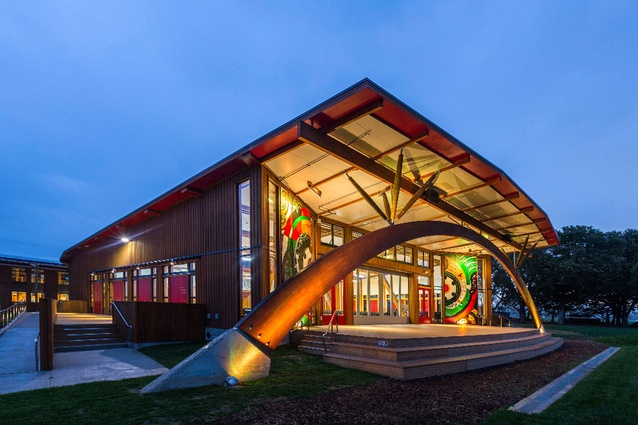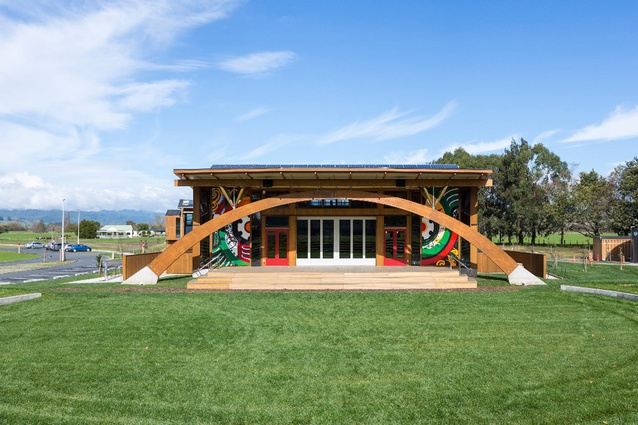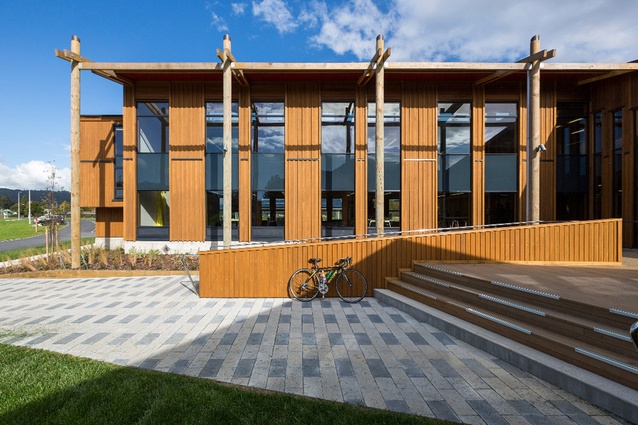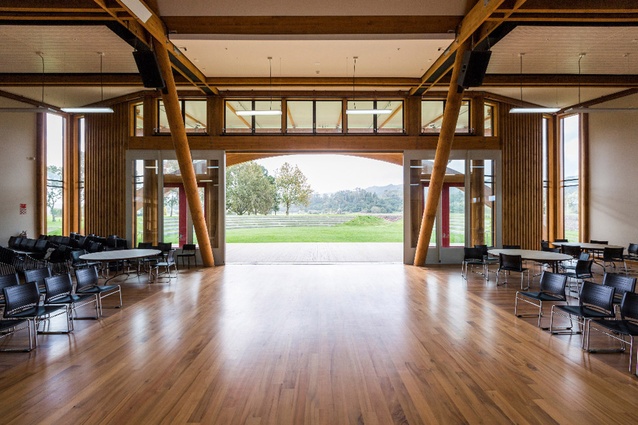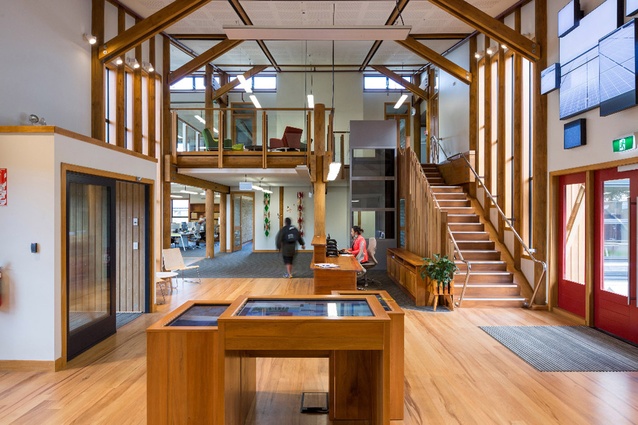Te Uru Taumatua, Te Wharehou O Tūhoe
There’s a wide diversity of architectural form in Māori buildings, both those designed by Māori and those built for them. The new iwi buildings, that we have seen sprouting up in these days of Treaty settlements, are another wave of architectural development. While marae largely operate at hapu- level, we have seen various movements over the last few centuries, such as Kotahitanga, Kīngitanga, Rātana and that at Parihaka, develop buildings for assembly, debate and governance. And, in the Nga-i Tūhoe rohe, Rua Kenana established an independent settlement at Maungapo-hatu in the early 20th century – with meeting hall, council room, bank, shops and housing – that lasted until a police assault saw Rua jailed.
Te Uru Taumatua is the new Tūhoe building designed by Jasmax, with Ivan Mercep as lead architect until his death. It is located in Tāneatua, at the head of the valley that leads back through Ruatoki to the densely forested and now sparsely populated Urewera hill country. This is an area that has seen much drama over the last few hundred years and, appropriately, is also located on a seismic fault-line. The new building is the first thing you see upon entering Tāneatua, with a glimpse of the arched front visible through surrounding berms that will be planted up in the future. Approached from a long driveway through car parks, the complex has a sense of corporate apartness in its location, a centralised HQ, somewhat of a bastion, perhaps as a result of Tūhoe’s past and recent history of incursion by hostile forces. In the future, once planting grows up, the entry will become more of a curving path into a forested glade.
One reason for the expansive grounds around the building is the need for extensive sewage and stormwater disposal fields, as well as infrastructure for gathering water, harvesting solar energy and also developing a series of gardens and orchards. The building was designed and built in accordance with the Living Building Challenge (LBC). This is a sustainability certification programme of the International Living Future Institute that is much more stringent than are the usual green exercises. But it seems to offer a much more holistic approach, encompassing not just a good built result but improvements in the manufacturing and service sectors and better social outcomes as well – a bold ambition.

The LBC requirements do seem to have a synergy with Tūhoe’s goals as kaitiaki and the need for a demonstration of environmental responsibility. The first thing that strikes you as you enter the building is the smell: a natural timber scent I’ve encountered before in newly built indigenous structures such as fale – not the usual whiff of synthetic and possibly toxic stuff. The LBC criteria have required exhaustive attention to material sourcing and that’s just one of the performance areas. Others aim for the structure to not just reduce its environmental impact but to be restorative. What most excites me, however, is the extent to which local materials and people were involved. As the builder (Arrow International) put it: “an incredible challenge: we’re pulling timber out of the forests to make the timber cladding and flooring; pulling mud out of rivers to make bricks; employing locals to build it; and using local materials wherever and whenever we can…” There are some innovations here that make complete sense such as salt-treated piles, rather the factory-produced, toxic alternative. The building is not quite off the grid but this self-contained and independent quality is also a nice metaphor for Ngāi Tūhoe in terms of tino rangatiratanga, as they were one of the last iwi to be subjugated and dispossessed. In post-Treaty settlement times, Tamati Kruger, chairman of Tūhoe, has said the building aims to be a marker for a way ahead.
So, given this emphasis on the local and on sustainability in its construction, what’s the building like? It could perhaps be more expressive of the efforts that have gone into its formulation if it had a more hetereogenous quality, reflective of the terroir and the many hands that contributed to it. For example, the timber cladding is freshly milled for the project from ‘dead and down’ trees sourced by Tūhoe in the local area but you don’t get any sense of that from the tectonics of the structure; the timber appears as if it may all have just came from PlaceMakers. That may or may not be a good thing but I’d like to see a building that speaks more of how it came into being, since this is a community facility and the innovations brought about by the LBC have been a massive factor in its birth. The act of building seems as important to this structure as is the final form and worthy of celebration. LBC certification involves not just box-ticking at the end of the job but a year’s worth of documentation proving compliance – a big ask, not just for designers, tradespeople and suppliers but for clients and the building’s occupiers as well.
After numerous design variations, the structure ended up split into two blocks, separated by a link with the main entry in the centre. This is a fairly standard division into a two-storeyed administrative area and a more public community wing that makes the buildings functions more transparent to an outsider than would just one bulk. Buildings such as this can be seen as built representations of an entity’s organisation and, at least here, a visitor enters directly into the heart of things; the bureaucrats are right at hand, not hidden away down corridors or behind layers of walls. The central link is stretched out to allow sunlight penetration and views out to future gardens and an orchard. It also contains a café space for both staff and visitors and an information area and displays detailing Tūhoe history and issues, as well as an archival centre.
The exterior is less welcoming, though, with little in the way of a porch over the entry or verandahs or overhangs around the building. These were part of the original design but were removed at the client’s wish so, as a visitor walks around the main volume of the communal block with its line of egress doors opening onto a deck, the side of the building has a blunt hall-like ambience masking the interior. The front of the tribal chamber is spectacular, however, and this is what those entering the Tūhoe rohe first catch a glimpse of from the highway. The lean-to roof rears up towards the north, balanced on a laminated timber arch that relates to the sun’s path and symbolises the sun at its zenith, as is also seen on the Tūhoe flag. It’s a striking frontage and turns the building into a gateway, a guardian at the head of the valley. And, suitably for an iwi as distinct as is Tūhoe, it’s formally unlike any other building in the land. Earlier iterations of the design incorporated this arch structurally throughout the building but I prefer it as a unique element with a symbolic meaning rather than as an element of structural expression.
In front of the archway is an open space surrounded by seating that can function as an a-tea does in front of a meeting house. The interior of the tribal chamber is a vast space with a clerestory opening back in the direction of the valley, propped by massive logs wrestling two large trusses into place, which speak to me of the rugged landscape and forests of the Ureweras. Several artworks around the complex are also, like the building, deliberately avoiding too much customary practice in favour of utilising forms and technology that demonstrate engagement with the contemporary world. Above the symbolic arch, the rooftop bristles with solar panels that relate to the sun in a much more pragmatic way.
This is one of Ivan Mercep’s last buildings. JASMaD, now Jasmax, and Ivan have quite a history of buildings for Māori and Polynesian clients, as well as buildings with an overtly bicultural agenda such as Te Papa. The 1980 Samoa House in Auckland’s Karangahape Road is a wonderful hybrid while, personally, I have found some of the meeting houses to owe too much to the stereotypical image of marae buildings and sources from other times and places. Similarly, The University of Auckland’s fale is constrained by the exigencies of building a tropical indigenous building in the cooler climes of a land governed by NZS 3604. Their more successful buildings find new forms and aim to do what Tūhoe chairman Tamati Kruger says of Te Uru Taumatua: “to reflect Tūhoe’s beliefs for its own and New Zealand’s future”. Is this building successful? Tūhoe’s future will be one of the measures of that. It’s a building built not just on the seismic fault-line that runs up the Ruatoki Valley, but on the cusp of a post-Treaty settlement period. As another epoch in New Zealand’s fractious history, we will have to wait and see how that turns out.

